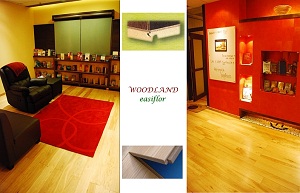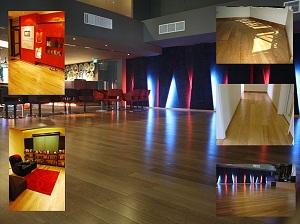Laminate flooring often made of melamine resin, a compound made with formaldehyde.
In the EU, the maximum allowed concentration of formaldehyde in finished wood flooring products is 0.2%, and any product that exceeds .05% has to include a warning that the product contains formaldehyde.
Laminate flooring (also called floating wood tile in United States and Canada) is a multi-layer synthetic flooring product fused together with a lamination process. Laminate flooring simulates wood (or stone, in some cases) with a photographic applique layer under a clear protective layer. The inner core layer is usually composed of melamine resin and fiber board materials. There is sometimes a glue backing for ease of installation. It has the advantages of being attractive, while costing less than natural floor materials, and of being more durable than carpet.
Laminate flooring is often made of melamine resin, a compound made with formaldehyde. There has been increasing concern about indoor air quality from releases of volatile organic compounds from building materials made with formaldehyde.
In view of its widespread use, toxicity and volatility, exposure to formaldehyde is a significant consideration for human health. On 10 June 2011, the US National Toxicology Program has described formaldehyde as “known to be a human carcinogen”.


It is our great pleasure to announce that our Eco-Art strip-flooring (cert) and Engineered hard-wood flooring (cert) have undergone stringent Organic Emission limits test (that complies with SGBC Green Building Product Certification Criteria for Wood Composite of section 4.4.2.) and are Singapore Green Building Product (SGBP) Certified with rating of 2 ticks as of 23 March 2011 under the pioneer and pilot batch of companies with products certified under the SGBP Certification Scheme.
SGBP Certification through its scheme provides a holistic, accurate and comprehensive assessment that matches BCA Green Mark assessment needs. FAQs of SGBP Certification can be found here.
A full page SGBC/SGBP advertorial that was published in the Business Times on 24 March 2011 can be found here.
Contact: Peter Carlisle at info@qscthailand.com for details of Woodland easiflor Pte Ltd’s 3-Ply Engineered Hardwood Flooring and Eco-Art Strip Flooring products.
Singapore Green Building Product Certification
About the Certification
The Singapore Green Building Council (SGBC)’s Green Building Product Certification Scheme, was launched on 14 September 2010 as a key initiative to support the building industry in the drive towards sustainability and environment- friendly built environment. The Certification is the 1st dedicated green building product certification scheme to support the BCA Green Mark Scheme. It is a Scheme with criteria formulated by more than 90 building professionals, assesses the level of environmental friendliness of building products in areas of safety, health, performance efficiency and environmental protection. The certification will provide consumers, building industry stakeholders, and government procurement system an excellent listing of robustly assessed and certified green building products.
Objective
SGBC’s Singapore Green Building Product Certification provides a meaningful differentiation of safer, healthier, efficient and sustainable products for the building industry. The Certification certifies building products that are resource efficient, have potentially better efficiency and lower environmental impact, provide better indoor environmental quality for a healthy, productive workplace in buildings.
Criteria for the Certification
The Certification adopts and makes reference to international standards and well established global eco-labelling and certification schemes. The Certification adopts the multi criteria and where feasible life cycle approach in its assessment criteria. The Certification seeks to encourage manufactures to improve product development and strive for greener innovation in products by adopting grading system to accord higher grading for greener products and to set direction for continual improvement.


